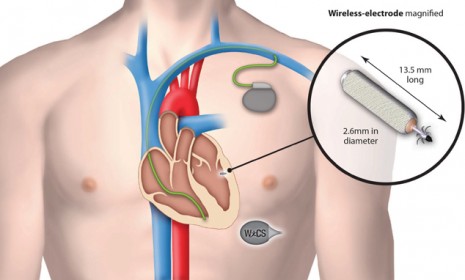The wireless pacemaker as small as a grain of rice
A tiny, no-fuss device promises to keep faulty hearts beating on schedule. How does it work?

A new wireless, ultrasound-powered pacemaker promises to make implantation easier for doctors, and life more comfortable for patients. The device, which was unveiled Monday, is currently undergoing a rigorous trial in Europe. If those tests are successful, this new pacemaker could hit the commercial market soon. Here's how it would work:
Remind me: What does a pacemaker do?
An artificial pacemaker is implanted in the chest of a cardiology patient "to help restore a normal heartbeat," says The Economist. Traditionally, the device consists of a battery and control system implanted "just under the wearer's skin," and electrodes attached directly to the heart. If a person's heartbeat becomes irregular, the system "deliver[s] an electrical charge from the artificial pacemaker's batteries that causes the cardiac muscle to contract, pacing the pumping."
The Week
Escape your echo chamber. Get the facts behind the news, plus analysis from multiple perspectives.

Sign up for The Week's Free Newsletters
From our morning news briefing to a weekly Good News Newsletter, get the best of The Week delivered directly to your inbox.
From our morning news briefing to a weekly Good News Newsletter, get the best of The Week delivered directly to your inbox.
What's so special about this new version?
Usually a pacemaker's battery is connected to the electrodes through a complex system of leads fed through a person's veins. This new device, called a wireless cardiac simulation (WiCS) system, has no wires at all. Instead, it uses ultrasound to transmit signals and energy between the battery and electrodes, says Duncan Graham-Rowe at Technology Review. The implantable receiver is about the size of a "grain of rice," and converts ultrasound signals into heart-regulating electricity.
And this is better?
Potentially. By eliminating wires, the device "simplifies the delivery and implantation of the system and means you can put the electrode in a place where it can better mimic the body’s natural electrical-to-muscle movement," says Andrew Diston, head of global medical technology practice at Cambridge Consultants, which developed WiCS along with EBR Systems. Plus, "all leads are prone to failure, especially when they are exposed to continual movement inside the body." This new device means less invasive surgeries and less chance of patient infection.
A free daily email with the biggest news stories of the day – and the best features from TheWeek.com
Sources: The Economist, The Engineer, Technology Review
-
 Political cartoons for December 11
Political cartoons for December 11Cartoons Thursday's political cartoons include sinking approval ratings, a nativity scene, and Mike Johnson's Christmas cards
-
 It Was Just an Accident: a ‘striking’ attack on the Iranian regime
It Was Just an Accident: a ‘striking’ attack on the Iranian regimeThe Week Recommends Jafar Panahi’s furious Palme d’Or-winning revenge thriller was made in secret
-
 Singin’ in the Rain: fun Christmas show is ‘pure bottled sunshine’
Singin’ in the Rain: fun Christmas show is ‘pure bottled sunshine’The Week Recommends Raz Shaw’s take on the classic musical is ‘gloriously cheering’